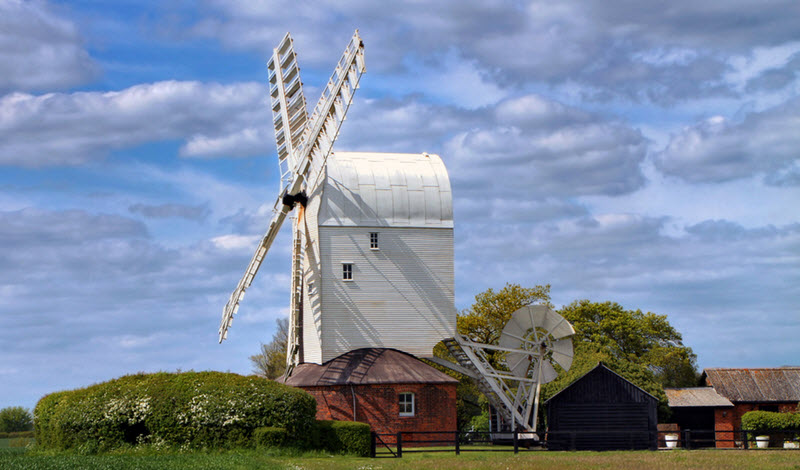Contents
Aythorpe Roding Windmill is an old windmill in Essex that was in use until 1937. It was restored back to working order in the early 1980s and started grounding grain again on 3 March 1982. The following year, the mill was opened to the public.
The Aythorpe Roding Windmill is a post mill with a single-storey roundhouse. With a body meassuring 21 feet by 12 feet in plan, this is the largest post mill in all of Essex. It is 44 feet 3 inches to the roof.
The mill, which is winded by fantail, is equipped with four double patent sails on a cast-iron windshaft. The crown tree is 20 inches square in sections at the ends and 20 inches by 19 inches in the centre. There are two pairs of millstones in the breast of the mill.
The Aythorpe Roding Windmill is designated Grade II* on the National Heritage List of England.

Location
Aythorpe Roding is a village in the Uttlesford district of Essex in eastern England. It is located 9 miles northwest of the town Chelmsford.
| Mill location | TL 590 152 |
| Coordinates | 51°48′43″N0°18′25″E |
Short facts
| Mill name | Aythorpe Roding Mill |
| Purpose | Gristmill |
| Type | Post mill |
| Storeys | Three storeys |
| Roundhouse storeys | Single storey roundhouse |
| No. of sails | Four sails |
| Type of sails | Patent sails |
| Windshaft | Cast iron |
| Winding | Fantail |
| Fantail blades | Six blades |
| No. of millstones | Two pairs |
Trestle and roundhouse
The crosstrees are 24 feet long.
The upper crosstree is 10 inches by 10 inches in section. It consists of two pieces of timber that has been scarf jointed in the vertical plane, with an iron plate bolted under the join.
The lower crosstree, which is 13 inches by 12 inches, bears the date 1869. This is probably when the roundhouse was built.
The main post is 20 feet 3 inches long, and 30 inches by 29 inches in section at the base.
Sails and windshaft
The current windshaft is made out of cast-iron and fitted with four double patent sails.
The whindshaft was probably made for another mill and then eventually being purchased second-hand for the Aythorpe Roding Windmill, because it is longer than what’s required for this mill.
Machinery
The brake wheel – which is 10 feet 2 inches in diametre – has a six-armed, cast-iron centre and a wooden rim.
The wallower is wooden, and was originally made for another mill.
History
The current windmill is not the first one on this site. Exactly for how long windmills have been on this spot remains unclear, but we know that there was one here as early as 1615.
The current windmill bears the inscription 1779 on a timber and was probably built in this year. In 1798, it as insured for £50.
19th century
- In 1805, the mill was insured for £140.
- On the Tithe Map from 1846, the mill is drawn as having an open trestle.
- On 10 February 1860, the mill was advertised in the Chelmsform Chronicle as “for sale to be pulled down and removed by the purchaser”.
- At some point, probably in the 1860s, the mill was modernised.
This involved changing the mill in many different ways. The layout of the millstones were changed from head and tail to breast, a roundhouse was erected to protect the trestle (and probably also to be used as storage space), and a fantail was added to make the windmill turn automatically in the right direction when it was windy. The common sails were removed and replaced with patents, and the wooden windshaft gave way for one made from cast-iron.
- By 1890, a steam engine had been installed, which drove an extra pair of millstones in the roundhouse.
20th century
- The mill ceased operation in 1937.
- In 1940, the mill was leased by the Essex County Council.
- In the early 1980s, the mill was restored by Vincent Pargeter. This job was completed in 1982 and the mill ground its first new round of grain on 3 March that year.
- On 30 April 1983, the mill was opened to the public.
Millers of the Aythorpe Roding Mill
- William Glasscock 1615 (in the previous mill)
- Joshua Wright 1798
- Joseph Knight 1805
- Tabrum 1833
- Stephen Crossingham 1848 – 1850
- E P Bennett 1866
- James Webster 1874 – 1878
- Charles Large 1882
- Thomas Belsham 1890
- Ernest and John Belsham 1906 – 1937